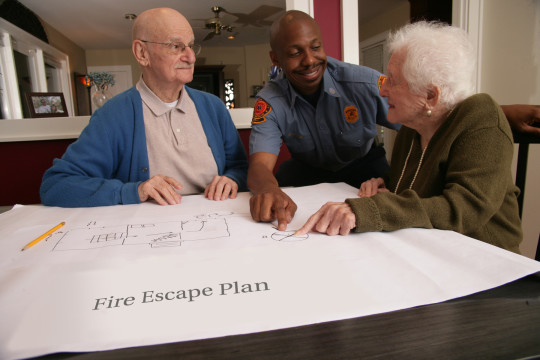
As summer draws to a close, it’s time to head back to school, meet new friends and say hello to fall. Just like teachers, books, and homework go together with the new school year, safety education should be a priority for every family.
The National Fire Protection Association and E.S.C.A.P.E. Fire & Safety offer these tips to play it safe!
 Bus Safety
Bus Safety
While waiting for the bus, take five giant steps back from the curb until the bus has stopped completely.
- Inside the bus, stay seated at all times.
- Keep your arms, hands and head inside the bus.
- Never throw anything about of the bus window.
- Always hold on the bus handrails when you are getting on or off the bus so you don’t fall.
- Be careful that clothing, book bags, and key rings don’t get caught in the handrails or doors.
- When exiting the bus, go to the closest sidewalk or side of the road and take five giant steps away from the bus.
- If you drop something near the bus, tell the bus driver. If you bend over to pick it up, the bus driver may not be able to see you.
 Safely Walking to School
Safely Walking to School
Children under age 10 should never cross a street without a grown-up.
- Choose a safe route to school. Look for the most direct route with the fewest street crossings.
- When crossing the street, stop at the curb or edge of the road.
- Look left, then right, then left again for moving cars before crossing.
- Keep looking left and right until you are safely across the street – and remember to walk, not run.
- Follow all traffic signals and markings.
- Don’t enter the street from between parked cars or from behind bushes or shrubs. Drivers might not be able to see you.
- Never wear head phones or talk on a cell phone when crossing the street.
 Bicycle Safety
Bicycle Safety
If you are old enough to ride alone, plan a safe route to school and have a grown-up ride with you the first few times.
- Children under 10 shouldn’t ride on the road without a grown-up.
- Be sure that your helmet fits. It should sit even on top of the head – not rocking in any direction – and always fasten the safety strap.
- Learn the proper hand signals and use them when you turn or stop.
- Walk, do not ride your bike across the street.
- Come to a complete stop before entering driveways, paths, or sidewalks, then look left, right and left again for bikes, cars or pedestrians heading your way.
- Do not ride at night.
 Car Safety
Car Safety
If you are riding to school in a car, the safest place to be if you are 12 years old or younger is in the back seat buckled up safely. Remember, you should be in a booster seat until you are eight years old and 80 pounds.
 Fire Safety
Fire Safety
And last, but not least, this is a great time to review and practice your home fire escape plan and prepare children for the first fire drill of the new school year.
When the fire alarm activates:
- Stop what you are doing and immediately exit the building. Remain quiet and listen for further instructions from a teacher or over the public address system.
- Once you are outside, go quickly to your meeting place for roll call.
- Always know 2 ways out of any room (like a door and window) in case one exit is blocked by smoke or fire.
- Never go back inside – Get Out and Stay Out.
The #1 item students need when they return to school is an abundance of safety knowledge. It is important for parents to stay up-to-date on the proper safety precautions and share this information with children to keep them safe at home, the mall, library or school throughout the year.














 Fire Safety
Fire Safety

